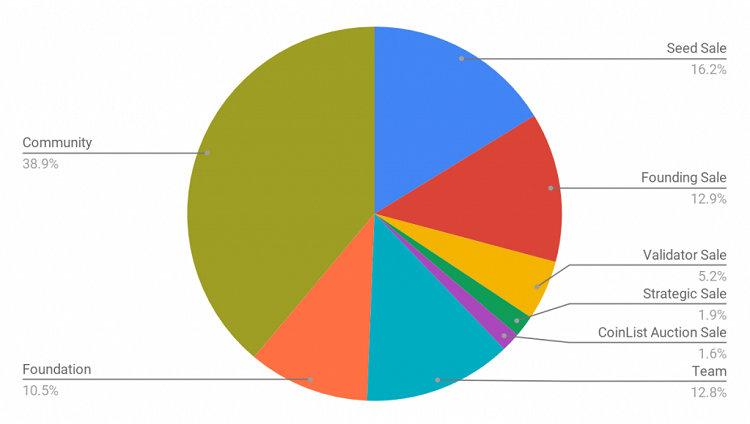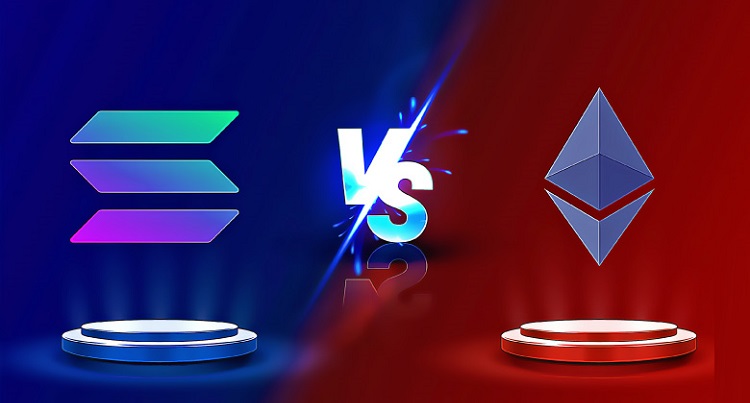Solanais one of the blockchain projects that launched in 2020 and has garnered significant interest from cryptocurrency enthusiasts for being seen as a direct competitor to Ethereum. Currently, Solana (SOL coin) has become the 6 largest cryptocurrency by market capitalization.
So, what is SOL coin, what is Solana and why has Solana gained such attention? Should you invest in SOL coin? Here are some things you need to know about Solana so you can decide whether to choose it in this potentially risky coin market.
Contents
What is Solana?
Solana (SOL coin) is a platform developed to address three challenging issues of Blockchain: decentralization, security, and scalability. Solana aims to build a system that can scale more efficiently, with faster speeds than any existing blockchain network currently.
The Origin of Solana:
The Solana platform (SOL coin) was founded in 2017 by Anatoly Yakovenko. Yakovenko worked at Qualcomm before establishing Solana. Additionally, he has extensive experience after working at Dropbox as a software engineer. Along with Eric Williams and Solana’s CTO, Greg Fitzgerald, they created a new process to address the traditional throughput issues still present in the Bitcoin and Ethereum blockchains.

The founding team of Solana hoped to create a decentralized protocol that allows for system scalability without compromising decentralization. They are currently receiving support from many top experienced organizations around the world, including Qualcomm, Apple, Intel, Google, Microsoft, Twitter, Dropbox, etc.
The impact that Solana has created also attracted the attention of many investors including: Foundation Capital, Multicoin Capital, SLOW Capital, CMCC Global, Abstract Ventures, etc.
What is SOL token?
Solana Token (symbol SOL) is the base currency of the Solana platform, created to power applications within its ecosystem.
SOL Key Metrics
- Name: Solana.
- Ticker: SOL.
- Blockchain: Solana.
- Token type: Utility Token.
- Token Standard: SPL.
- Contract Address: 0x22c421ba4717edaf6b6bda424207a7335e8f0e52
- Max Supply: 1,000,000,000 SOL.
- Total supply: 561,946,338 SOL
- Circulating Supply: 508,706,265 SOL
SOL Token Use Cases
- Transaction fees: SOL is used to pay for transaction fees incurred when users utilize the Solana blockchain network.
- Reward: SOL is also used as a reward for staking or nodes to ensure the stable operation of the network.
- Governance: SOL holders may vote on upgrade proposals and governance for future community proposals.
Like Ethereum, Solana allows developers to build smart contracts on its blockchain. SOL uses the SPL protocol (Solana blockchain’s token standard), similar to Ethereum’s ERC20.
SOL Token Allocation

What Makes Solana (SOL coin) Special?
To decide whether to invest in Solana and its SOL token, you need to understand the following about Solana.
Solana is an alternative to Ethereum
A major driving force behind Solana’s strong growth is because it is currently an alternative to Ethereum. Ethereum is the world’s second-largest cryptocurrency and was the first to introduce smart contracts.
Smart contracts are small pieces of code that allow blockchain platforms to run decentralized applications (dApps) and other programs.
However, Ethereum is experiencing serious congestion and high transaction fees. Therefore, a new platform like Solana, which is both fast and inexpensive, will attract more attention than ever. Many have dubbed Solana “ Ethereum killer.” Both platforms are competing to attract developers to gain as much market share as possible.

Most developers will consider Ethereum before trying any other blockchain. However, Ethereum’s main issues are scalability, stability, and increasing transaction fees. Therefore, this will be an opportunity for blockchains that can overcome Ethereum’s disadvantages. And Solana fits this bill perfectly.
Solana is one of the fastest cryptocurrencies
One of the big draws of Solana is that it can handle about 50,000 transactions per second (TPS). In contrast, Ethereum processes between 15 and 45 TPS (although it is in the process of upgrading to ETH2 to make it a bit faster), but it still falls far short of Solana.
While processing speed is not everything, few cryptocurrencies can keep up with Solana in this race. It’s worth noting that Solana’s transaction fees are incredibly low, so it may even compete with Visa or Paypal’s payment systems in the future.
Let me try to give you a comparative example:
- Solana can process 50,000 transactions per second.
- Visa says they handle about 24,000 transactions per second.
- A transaction on Solana costs only about $0.0001.
- A transaction on Visa or MasterCard typically costs about 1.5 – 2.5% of the total transaction value.
=> For large traders, this advantage of Solana is very good. Suppose you are a merchant dealing with $1 million. Doing it on Solana is both fast and free, but with Visa or MasterCard, it would cost about $15,000 to $25,000. Which one do you prefer?
Solana (SOL coin) uses proof of history
What is Proof-of-History (PoH)? Let me explain it to you.
- Bitcoin uses a consensus mechanism called PoW (Proof-of-Work) for miners to validate transactions and create new Bitcoins.
- Cardano uses a proof of stake called PoS (Proof-of-Stake), which helps participants in the network stake their tokens to validate transactions and earn newly minted tokens.
=> In both cases above, all computers in the network have to come to an agreement on certain points, including the timing of a transaction. Solana uses a combination of PoS and a new mechanism – PoH.
*** *** Proof-of-History (PoH) is a consensus algorithm that helps nodes agree on the time and order of events to make decisions, thus reducing transaction costs and latency.
Solana’s ecosystem is growing strongly
In the fierce competition among Ethereum alternatives, a very important battleground is the number of projects running on each network. Ethereum may be slow, but it has the first-mover advantage, and developers are accustomed to using its platform and programming language. Therefore, Ethereum still holds a large market share of dApps.

Solana itself has hundreds of projects in its ecosystem. These include decentralized finance (DeFi) applications that offer intermediary-free banking services, non-fungible token (NFT) projects, gaming applications, and many more.
Should you buy Solana (SOL)?
If you already know what Solana is and understand the most notable features of the Solana coin that I just analyzed above, then perhaps you are also wondering whether you should invest in Solana or not?
Below are the most notable pros and cons of Solana:
Following the unforeseen FTX debacle in November 2022, Solana has exhibited continual growth. Even in the face of such turmoil, the usage data for Solana paints a highly optimistic picture. Despite this, Solana (SOL) has been criticized for a significant period due to the frequent downtimes of its network. These incidents have gradually eroded investor confidence in Solana.
While SOL coin no longer has the allure it did in 2021 and 2022, we cannot deny that Solana has an impressive platform. In the current cryptocurrency market, most of the value is concentrated in Ethereum and various EVM chains. Because it is open-source, projects can easily “copy” from previous ones, which saves a great deal of development effort. However, on the flip side, we see that these ecosystems tend to be quite similar to each other and lack significant breakthroughs.
Solana is a platform with a different direction, and its special features can be mentioned as:
- It is the first ecosystem outside Ethereum to have a second client (Firedancer). This will help increase Solana’s stability, security, decentralization, and network compatibility.
- Solana has developed its phone with a specialized toolkit, allowing developers to create decentralized applications on mobile phones. Currently, there are exclusive applications developed on Saga.
- Solana is also a suitable environment for projects with new concepts. The fast speed and low cost of Solana are truly becoming an advantage for nurturing new projects.

A few projects with unique concepts that stand out on Solana include:
- StepN: Combining fitness tracking and tokenomics
- Helium: A project for network connectivity hotspots, which has also moved to Solana
- Monaco Protocol: Infrastructure for rapid development of betting platforms.
- NFT backpack: Framework to create, manage, and bundle NFTs
- Hivemapper: Decentralized mapping project.
- Payment applications like Solana Pay, Sphere.
In summary:
At present, Solana still has to navigate quite a bit in terms of development and attracting users. Several incidents over the past few years, along with the emergence of many competitors, have made Solana lose the “golden age” it once achieved.
At present, Solana (SOL coin) still has to navigate quite a bit in terms of development and attracting users. Several incidents over the past few years, along with the emergence of many competitors, have made Solana lose the “golden age” it once achieved.
Solana (SOL)
Where to Buy and Sell Solana (SOL coin)?
Solana can currently be traded on 33 different cryptocurrency exchanges, many of which are large platforms such as Binance, OKEx, Hoo, Bitmax, Coinbase, Bitfinex, MXC, Bithumb Global, Gate.io, Huobi Global, and more.
For a detailed list of these exchanges, refer to their official website:
- https://solana.com/ecosystem?categories=exchange
How to Store SOL?
To store SOL coin, you must use a wallet dedicated to SOL or a multi-chain wallet. Here are some options for you:
- Exchange Wallets: All exchanges that support SOL, such as Binance.
- Web Wallets: SolFlare, Sollet, MathWallet
- Mobile Wallets: Trust Wallet, Coin98 Wallet
- Hardware Wallets: Ledger Nano, Trezor
-
What is Solana? Solana (SOL coin) is the currency of the Solana platform – a platform developed to address the “Blockchain trilemma.”
-
Solana is on a strong development path to work alongside other blockchains to deliver optimal solutions for users.
-
Solana is one of the fastest cryptocurrencies, and many see it as a potential alternative to Ethereum.
-
Despite its reputation being affected by the FTX incident, it’s undeniable that Solana possesses superior technology and direction.
-
The potential for Solana in the future remains vast, making it suitable for long-term investment.
-
At the time you are reading this article, Solana is priced at $ 141.02 ([mcrypto coin=”SOL” info=”change”]), and ranks 6 in the market by market capitalization.
You might be interested in:
Above is the information about Solana (SOL coin) that we want to share with you. Hopefully, through this article, you have understood what is Solana is, what is SOL coin, its impressive features, and whether you should invest in Solana or not. Think wisely, and we wish you successful investing.















